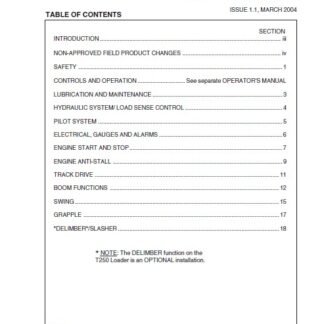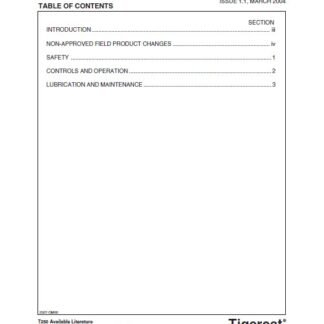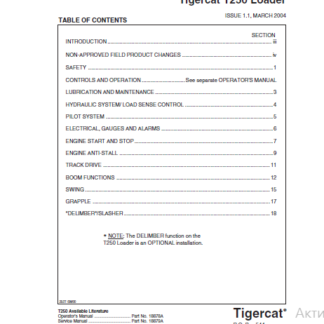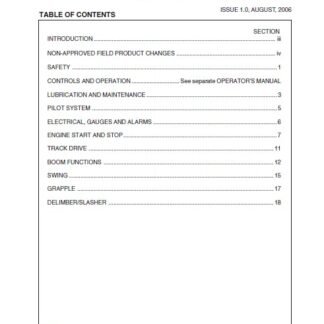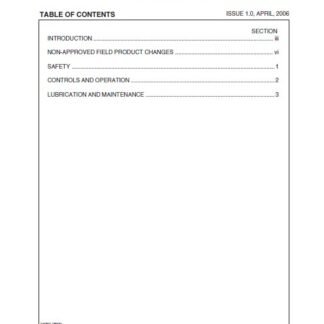
In the world of heavy-duty forestry equipment, Tigercat stands out as a leading manufacturer known for its robust machinery and innovative designs. For professionals who rely on Tigercat equipment, maintaining peak performance is crucial, and this begins with using the right repair manuals. While there may be various options available, insisting on an OEM (Original Equipment Manufacturer) factory authorized Tigercat repair manual is essential. This article delves into the reasons why OEM manuals are indispensable and the potential risks of using non-OEM alternatives.
Understanding OEM and Factory Authorization
OEM, or Original Equipment Manufacturer, refers to the company that originally manufactured the equipment or its components. When it comes to repair manuals, an OEM manual is one that is produced by the equipment’s original manufacturer, in this case, Tigercat. Factory authorization further emphasizes that these manuals are officially approved and endorsed by the manufacturer, ensuring they meet rigorous standards. This means that the information contained within these manuals is accurate, comprehensive, and specifically tailored to the equipment in question.
Factory authorization is a stamp of legitimacy that assures users that the repair manual they are using is not only accurate but also up-to-date with the latest technical specifications and repair guidelines. Tigercat, known for its precision engineering, ensures that its authorized manuals contain detailed instructions, diagrams, and troubleshooting tips directly from the engineers who designed the machinery. This direct line of information from the source is invaluable for performing repairs and maintenance correctly.
Using an OEM factory authorized manual provides peace of mind, knowing that the information is not only comprehensive but also designed to protect the integrity of the equipment. This is particularly important for complex machinery like Tigercat’s, where even minor discrepancies in repair guidance can lead to significant performance issues. Moreover, these manuals are often updated to reflect any changes or improvements in the equipment, keeping users informed with the most current information available.
For those who operate and maintain Tigercat equipment, understanding the difference between OEM and non-OEM manuals is crucial. The former offers a level of precision and reliability that is unmatched, stemming from direct collaboration between the manual’s creators and the engineers behind the equipment. This ensures that operators have access to the highest quality repair instructions, which are essential for maintaining the longevity and efficiency of their machinery.
Importance of Authentic Tigercat Repair Manuals
Authenticity in repair manuals is crucial for ensuring that equipment is maintained to the highest standards. An authentic Tigercat repair manual is crafted with a deep understanding of the machinery’s design and operational parameters. Such manuals include detailed schematics, precise part numbers, and specific maintenance routines that are essential for the proper upkeep of Tigercat equipment. This level of detail can only be guaranteed when using a genuine OEM manual.
The importance of using an authentic manual cannot be overstated, especially when dealing with complex forestry equipment. Tigercat’s machinery often operates in demanding environments, requiring meticulous maintenance to prevent downtime and costly repairs. An authentic OEM manual provides step-by-step instructions that are crucial for technicians to follow, ensuring that each component is serviced correctly and efficiently.
Furthermore, authentic Tigercat repair manuals are designed to provide clear and concise instructions, minimizing the risk of misinterpretation. This is particularly beneficial for technicians who may be new to working with Tigercat equipment. By providing clear guidance, these manuals help reduce the likelihood of errors during repair and maintenance procedures, which can lead to improved machine reliability and performance.
Access to authentic manuals also supports compliance with warranty terms and conditions. Many manufacturers, including Tigercat, may require proof that OEM guidelines were followed during repairs to honor warranty claims. Therefore, using an authentic Tigercat repair manual is not just about maintaining the equipment but also about safeguarding the investment made in these high-value machines. For more information on authentic manuals, visit tigercat-manual.com.
Risks of Using Non-OEM Repair Instructions
Using non-OEM repair instructions poses significant risks to both the equipment and the operator. These manuals may lack the precision and detailed insights that OEM manuals provide, leading to potential errors during maintenance and repair procedures. Non-OEM manuals often contain generic information that may not be applicable to specific models or configurations, increasing the likelihood of incorrect repairs and subsequent equipment failure.
One of the primary risks of non-OEM manuals is the potential for outdated or incorrect information. Unlike OEM manuals that are regularly updated to reflect the latest technical advancements and changes in equipment design, non-OEM manuals may not receive such updates. This can lead to technicians using obsolete methods or incorrect parts, resulting in inefficient repairs and increased wear and tear on the machinery.
Additionally, non-OEM manuals might not adhere to the same quality standards as OEM manuals, potentially omitting critical safety warnings and precautions. This oversight can jeopardize the safety of operators and technicians, leading to accidents or injuries. In high-stakes environments like forestry operations, ensuring that every safety protocol is followed is of utmost importance, and non-OEM manuals may fall short in this regard.
Finally, using non-OEM manuals can impact the resale value of the equipment. Prospective buyers often seek assurance that the machinery has been maintained according to the manufacturer’s guidelines. A history of using non-OEM repair instructions might raise concerns about the equipment’s history and condition, leading to reduced buyer confidence and lower resale value. To avoid these risks and ensure optimal maintenance, always rely on OEM manuals from trusted sources like tigercat-manual.com.
Benefits of Insisting on OEM Repair Manuals
Insisting on OEM repair manuals brings numerous benefits that contribute to the long-term performance and reliability of Tigercat equipment. Firstly, these manuals provide the most accurate and detailed information available, directly from the manufacturer. This ensures that technicians are equipped with the knowledge needed to perform repairs and maintenance tasks with precision, reducing the risk of errors and enhancing equipment longevity.
OEM manuals also offer comprehensive coverage of the equipment, including specific details on each component and its function within the system. This holistic understanding allows technicians to diagnose and address issues more effectively, leading to quicker turnaround times and minimized downtime. For businesses that rely on Tigercat machinery, this translates to improved productivity and operational efficiency.
Furthermore, using OEM manuals helps maintain the equipment’s warranty coverage. Many manufacturers require that repairs and maintenance be conducted according to OEM guidelines to validate warranty claims. By adhering to these standards, equipment owners can ensure that they remain eligible for warranty protection, safeguarding their investment in the machinery.
Finally, OEM repair manuals foster a culture of professionalism and excellence in maintenance practices. By prioritizing the use of authentic and factory-authorized materials, businesses demonstrate their commitment to quality and safety. This not only enhances the reputation of the service provider but also instills confidence in clients and stakeholders. For access to OEM repair manuals, visit tigercat-manual.com.
In conclusion, the significance of using OEM factory authorized Tigercat repair manuals cannot be overstated. These manuals provide the most accurate, detailed, and up-to-date information necessary for maintaining Tigercat equipment at its best. By understanding the risks associated with non-OEM manuals and recognizing the numerous benefits of OEM guidance, operators and technicians can ensure their machinery performs optimally and safely. For those committed to excellence in maintenance practices, insisting on OEM manuals is a prudent and strategic choice.

